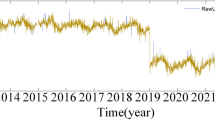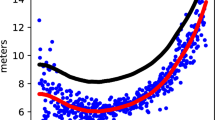Abstract
The window technique was suggested earlier to get rid of the double consideration of the topographic-isostatic masses within the data window in the framework of the remove-restore technique. Within the course of the window technique, one needs to compute the harmonic coefficients of the topographic-isostatic masses for the data window. The paper studies the effect of using Digital Height Models (DHMs) with different resolutions of the computed harmonic coefficients of the topographic-isostatic masses for the data window. Two different test areas, one in Austria and one in Egypt, are considered in this investigation. A set of DHMs with different resolutions is available for both test areas. The harmonic coefficients of the topographic-isostatic masses for the data window are computed for both test areas using the available DHMs with different resolutions. A comparison among the potential degree variances of the different DHMs is carried out. The computation of the window topographic-isostatic gravity anomalies for both data sets is performed using the set of the available DHMs with different resolutions. The results show that using a DHM with the grid size of about 5 km for smooth topography and of about 3 km for rough topography gives practically the same topographic-isostatic gravity anomalies for the data window in a significantly much less CPU time compared to that of using the finest DHM.
Similar content being viewed by others
References
Abd-Elmotaal H., 1998. An alternative capable technique for the evaluation of geopotential from spherical harmonic expansions. Bollettino di Geodesia e Scienze Affini, 57, 25–38.
Abd-Elmotaal H., 2011a. The new Egyptian height models EGH10. NRIAG J. Geophys., Special Issue, 249–261.
Abd-Elmotaal H., 2011b. FFT versus least-squares collocation techniques for gravimetric geoid determination in Egypt. J. Appl. Geophys., 10, 121–133.
Abd-Elmotaal H. and Kühtreiber N., 2003. Geoid determination using adapted reference field, seismic Moho depths and variable density contrast. J. Geodesy, 77, 77–85.
Forsberg R., 1984. A Study of Terrain Reductions, Density Anomalies and Geophysical Inversion Methods in Gravity Field Modelling. Report No. 355. Department of Geodetic Science, The Ohio State University, Columbus, OH.
Graf J., 1996. Das digitale Geländemodell für Geoidberechnungen und Schwerereduktionen in Österreich. In: Meurers B. (Ed.), Proceedings of the 7th International Meeting on Alpine Gravimetry. Publication 373, Zentralanstalt für Meteorologie und Geodynamik, Wien, Austria (in German).
Hofmann-Wellenhof B. and Moritz H., 2005. Physical Geodesy. Springer-Verlag, Wien, Austria.
Kühtreiber N. and Abd-Elmotaal H., 2001. Gravimetric geoid computation for Austria using seismic Moho data. In: Sideris M.G. (Ed.) Gravity, Geoid and Geodynamics 2000. International Association of Geodesy Symposia 123, Springer-Verlag, Heidelberg, Germany, 311–316.
Rapp R.H., 1982. A Fortran Program for the Computation of Gravimetric Quantities From High Degree Spherical Harmonic Expansions. Report No. 334. Department of Geodetic Science, The Ohio State University, Columbus, OH.
Rummel R., Rapp R.H., Sünkel H. and Tscherning C.C., 1988. Comparison of Global Topographic/Isostatic Models to the Earth’s Observed Gravity Field. Report No. 388. Department of Geodetic Science, The Ohio State University, Columbus, OH.
Sünkel H., 1985. An Isostatic Earth Model. Report No. 367. Department of Geodetic Science, The Ohio State University, Columbus, OH.
Tscherning, C.C., Knudsen, P. and Forsberg, R., 1994. Description of the GRAVSOFT Package. Geophysical Institute, University of Copenhagen, Technical Report.
Author information
Authors and Affiliations
Corresponding author
Rights and permissions
About this article
Cite this article
Abd-Elmotaal, H.A., Kühtreiber, N. The effect of DHM resolution in computing the topographic-isostatic harmonic coefficients within the window technique. Stud Geophys Geod 58, 41–55 (2014). https://doi.org/10.1007/s11200-012-0231-6
Received:
Revised:
Accepted:
Published:
Issue Date:
DOI: https://doi.org/10.1007/s11200-012-0231-6




